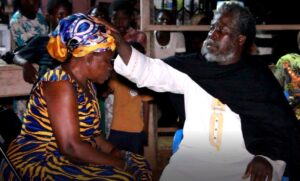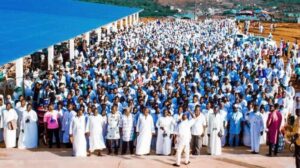
The Sin of Adam and Eve, the Forbidden Fruit, and KABBA, the First Temple of God
Teachings of Okronkronyi Nyame Somafo Yawoh
Written by Mensah Adinkrah, Ph.D.
Jesus Christ, a Messenger of God, brought divine wisdom and guidance to humanity. In his teachings, he emphasized the continuity of God’s revelation, acknowledging that other Messengers had come before him and that further guidance would follow after his time on earth. One of the most profound moments in his ministry occurred during an intimate conversation with his disciples. Jesus acknowledged the limitations of their understanding, saying, “I have yet many things to say unto you, but ye cannot bear them now” (John 16:12). This statement highlighted his recognition of their spiritual and emotional readiness at that moment. However, Jesus did not leave them without hope for greater enlightenment.
He foretold the coming of the “Spirit of Truth,” a divine figure or presence that would guide humanity into all truths. Jesus described this Spirit of Truth as one who would not speak independently but would convey what was given by God, including truths yet to be revealed. He assured his followers that this Spirit would not only illuminate their understanding of his teachings but would also provide insight into future matters, ensuring that divine wisdom remained accessible to humanity across generations. John 16:12 states: 12 “I have much more to say to you, more than you can now bear. 13 But when He, the Spirit of truth, comes, He will guide you into all the truth. He will not speak on his own; He will speak only what He hears, and He will tell you what is yet to come.
Okronkronyi Nyame Somafo Yawoh, Founder and Spiritual Leader of Asomdwee Ntonton Som—the Third Religion of the Most High God RABBI—is the Spirit of Truth foretold to descend upon the earth in the End of Days. Since His arrival, He has unveiled previously unknown revelations, illuminated mysteries that were once inscrutable, and provided profound insights into what lies ahead in the future.
In a recent teaching, Okronkronyi Nyame Somafo Yawoh shared profound insights into the story of Adam and Eve in the Garden of Eden, presenting a detailed account of their actions, their punishment, and their eventual path toward redemption. Okronkronyi Nyame Somafo Yawoh explained that the names Adam and Eve are rooted in a divine heavenly language. In this language, Adam translates to Obarima (man), and Eve translates to Obaa (woman). These names highlight their symbolic roles as the first man and woman in human history.
According to the teaching, Adam and Eve were placed in the Garden of Eden, described as heaven on earth—a divine sanctuary of perfection. Within this sacred space was a particular tree known as the atenka dua, or “tree of sexual desire.” God forbade Adam and Eve from eating the fruit of this tree, not because they were never to eat it, but because the appointed time had not yet come. The fruit represented a stage of maturity and divine approval they had yet to reach.
However, Satan, embodying the spirit of deception, entered the serpent and used it to mislead Adam and Eve. The serpent enticed them to eat the forbidden fruit prematurely, directly disobeying God’s command. Seven days after consuming the fruit, they experienced atenka, or sexual desire, which led them to engage in sexual relations in the Garden of Eden—an act that was forbidden in that holy realm.
For this transgression, Adam and Eve were cast out of the Garden. Okronkronyi Nyame Somafo Yawoh explained that it was Angel Michael, the warrior angel, who carried out this divine judgment, banishing them from paradise and severing their direct connection to God. After their expulsion, Adam and Eve were separated and placed in different locations on earth. Adam was set on the summit of Mount Everest, the tallest mountain on earth, while Eve’s location was Jeddah. Despite the separation, they began searching for each other, their longing for reunion fueled by their bond. Their paths eventually converged at Mount Alpha, where their shadows revealed their presence to one another. The next morning, they met, embracing in a heartfelt reunion.
Okronkronyi Nyame Somafo Yawoh’s account further described Adam and Eve as towering figures, each 90 feet tall, underscoring their extraordinary nature as the first humans. Following their reunion, Adam undertook a spiritual journey of repentance. He made his way to the Kaaba, a sacred site, where he sat daily in deep prayer. Circling the Kaaba, he repeatedly cried out, “Otumfo Nyankopon, fa me bone kyɛ me”—”Most High God, forgive me my sins.”
God, moved by Adam’s sincerity, sent Angel Gabriel to deliver a divine message. Gabriel instructed Adam to fast for forty days and forty nights as an act of spiritual purification. At the end of this period, Gabriel returned with the joyous announcement that Adam’s sins had been forgiven by God.
This teaching offers the true and authentic story of the Adam and Eve narrative, emphasizing themes of obedience, temptation, sin, and redemption. It underscores the profound consequences of human actions and the enduring power of repentance and divine forgiveness. Through Okronkronyi Nyame Somafo Yawoh’s teaching, the story of Adam and Eve is not only a cautionary tale but also a testament to the resilience of the human spirit and the boundless mercy of God.





